KEY CONCEPTS
•
Advancements in base oils are driven by requirements of evolving applications.
•
Base oils of lower viscosity and volatility are in high demand and growing.
•
Eventually, base oils will advance to completely new products as we know them today.
In recent years, in parallel with advancements in oil refining with process optimization and equipment modernization, base oils technology has gone through significant developments. The gas-to-liquids (GTL) process also is becoming an important contributor to the base stock pool by converting natural gas into liquid petroleum hydrocarbons, enabling new quantities of high-performance base stocks, which are catalytically synthesized from gaseous hydrocarbons, supporting the move from conventional to highly performing base stocks as required by end-users.
1
Moreover, globally, governments call for an end to fossil fuel era. In 2021, fossil fuel was formally deemed to be incompatible with a sustainable global future by an Intergovernmental Panel on Climate Change (IPCC).
2
Decarbonization initiatives have propelled a strong interest and initial uptake of electric vehicles
(see Figure 1). With this interest comes a shift in the design of automotive systems. The scientists project the rate of growth will be determined by the degree to which each advanced technology and low-carbon fuel can demonstrate economic growth.
2
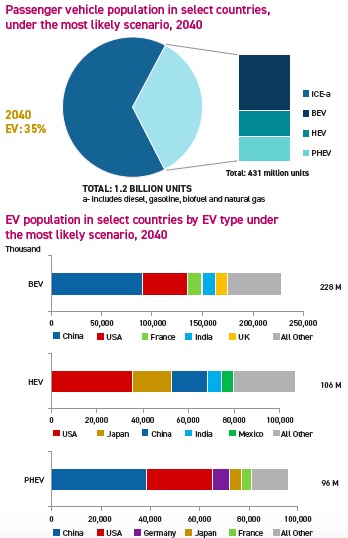 Figure 1. Internal combustion engine vehicles, battery electric vehicles, hybrids and plug-in hybrids will likely share the roads for the next two decades. Figure courtesy of The Kline Group.3
Figure 1. Internal combustion engine vehicles, battery electric vehicles, hybrids and plug-in hybrids will likely share the roads for the next two decades. Figure courtesy of The Kline Group.3
The changes in OEM product line mixes also are driving new (and existing) oil-related specifications, calling for fuel way to assist OEMs is through specially formulated lubricants. With this in mind, it becomes more and more necessary to replace conventional mineral base stocks with high performing options such as Group IV (polyalphaolefins [PAOs]) and Group III base oils
(see Table 1).
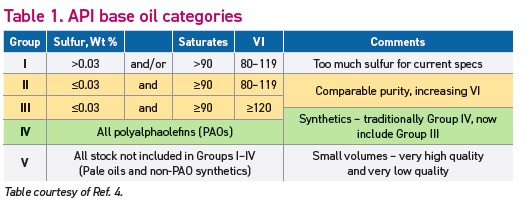 Group III and Group III+
Group III and Group III+
Group III base stocks are produced from feeds by hydroprocessing and catalytic dewaxing. They share the same low sulfur and high saturates characteristics. The distinction of Group III is the viscosity index (VI) range, which should be above 120. To make Group III quality, more severe hydroprocessing is used. GTL base stocks are similar in composition and performance to Group III base stocks; though synthesized from natural gas, GTL base stocks are similar to and identified as Group III base stocks.
1 One of the most significant drawbacks of Group III base oils is that the hydrocracking process does not allow going far beyond a KV100 of 10 cSt limiting high quality Group III mineral base stocks broad viscosity range versus synthetic PAOs.
Although not officially part of the API classification, individual companies manufacture Group III+ base stocks. These “plus” products all have VIs on the high end of the API guideline. Sulfur and saturates specifications remain unchanged from the official Group III classification. However, individual marketers have set their own VI expectations for these unofficial grades. For Group III+ minimum VI falls somewhere between 130-140. In addition to the high VI benefit, these base stocks generally have lower volatility and lower pour points than conventional Group III.
1 The common way to reach Group III+ VI quality is to start by refining slack wax or GTL wax feeds. The biggest challenge for Group III producers is to work with different crude feeds and refining products that can vary significantly in composition and performance, which impacts the quality of the Group III base oil and results in quality challenges for the finished lubricants producers. Group III+ advantages over conventional Group III are that it offers lower cold cranking simulator (CCS) viscosity and Noack volatility, better pour point and oxidative stability and can be a partial or full alternative to PAO in some applications.
1
PAO
PAOs are highly branched isoparaffin-like liquid hydrocarbons with a unique combination of high temperature viscosity retention, low volatility, very low pour point and a high degree of oxidation resistance. The VI of these base stocks can range from 125 to more than 200 with pour points down to -85 F (-65 C) or lower.
1 These extremely favorable characteristics result from the wax-free polymerization of linear olefins of predetermined chain length. These properties make PAOs ideal base stocks for high performance lubricants. Today, PAOs are used in a wide range of industrial and automotive applications and lead the synthetic lubricants demand in automotive engine oils, gear oils and driveline fluids. Recent advances in PAO technology have piloted even greater performance attributes in the area of high and low temperature performance, including sustainable and electrification fluids.
1
STLE Immediate Past President Dr. Ken Hope, global PAO technical services manager, Chevron Phillips Chemical, says that with the energy transformation, there are new developments in e-mobility:
•
Electric vehicles (battery electric vehicles, hybrids, improved ICE, renewable diesel, etc.)
•
Infrastructure for energy sources and distribution
•
Dielectric heat transfer and computation power needs (5G, cryptocurrencies).
These transformational factors and needs require improved thermal conductivity and electrical properties of heat transfer oils.
Regarding sustainable benefits of PAOs, Hope adds that low viscosity PAOs have good biodegradation capabilities (Modified Sturm Test, OECD 301B). PAOs also work well with vegetable oils for the following applications:
•
Biodegradable hydraulic oils
•
Transportation lubricants
•
Used by USDA, National Oceanic Atmospheric Administration (NOAA), several national parks due to the EPA’s preferred purchasing program for federal agencies
•
Vessel General Permit lubrication use.
Hope continues that PAOs’ long oil life supports minimizing waste, and lastly, friction reduction reduces energy consumption, which improves the overall sustainability aspect and highlights the capabilities
One of the biggest concerns the industry has in regard to PAO is its global availability as global PAO capacity sits around 750,000 metric tons per year, as per 2020-2021 Lubes’n’Greases Factbook.
5 According to Dr. Thomas Schimmel, vice president automotive, Evonik Oil Additives: “When looking at the overall lubricant market, PAOs have always been restricted to certain high-performance applications.” With regard to the capacity, Group III is leading: “The production capacity for Group III oils is 14 times the capacity for PAO
(see Table 2). Group III oils are produced in all relevant regions, and the production process can be scaled up to >1,000 kilotons (kt). Therefore, and in addition to a lower-cost manufacturing process, the economics are clearly in favor of Group III.”

Schimmel states: “Traditional applications for PAOs are synthetic engine oils and driveline fluids. Due to the absence of PAO manufacturing sites in Asia (only recently Sinopec started to produce PAOs in China), all Japanese and Korean passenger car OEMs have adjusted their engine oil specifications to accommodate Group III base oils.” Hope adds: “Nowadays PAOs are distributed globally even though the three major producers do not have current production capabilities in Asia.”
Answering to the market concerns, PAO manufacturers are adding significant capacities to address the volume growth worldwide.
While comparing some typical properties for a PAO 4 and a similar Group III+ oil, Schimmel sees many of the earlier clear performance advantages of PAO (like high VI, high flash point, low Noack volatility) disappearing with recent improvements of Group III oils.
“Some parameters remain favorable for PAO: the low pour point, the low mini-rotary viscosity (MRV) and the low CCS viscosity, due to the complete absence of paraffin-like molecules, and the outstanding oxidative stability. The very homogeneous chemical composition of PAO comes with a disadvantage, however; PAOs exhibit a very low polarity, leading to poor solvency for polar additives. Therefore, PAOs are almost always used alongside polar base oils like esters (a Group V base oil), which are costly and can bring certain unfavorable properties (e.g., poor hydrolytic stability)
(see Table 3).”
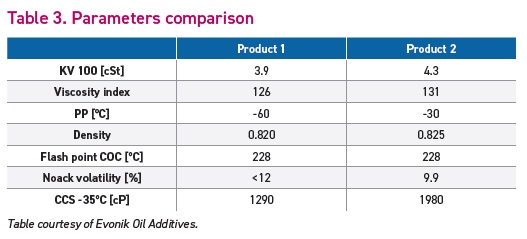
STLE member Ke Jian Liang, technology director, Asia Pacific, Afton Chemical (Suzhou) Co., Ltd., says, “The performance advantage gap between PAO and hydrocracked base oils is closing, but it will never fully close the performance. Specifically, the introduction of much higher VI Group IIIs (so called Group III+) bring improved performance due to the very specific chemical nature of the base oil, specifically the VI, the volatility and viscometric balance. The ‘inherent’ performance of the Group III+ is not the driving factor—rather it is the manner in which they allow a formulator to put together the final fluid formulation in the most cost effective manner. But still, aspects such as volatility and VI are still short of where PAO is.”
Some other advantages of PAO versus Group III can be observed while comparing friction of PAO versus Group III (4 cSt) oils
(see Figure 2). Hope says:
•
Mini Traction Machine (MTM) generated traction curves of equiviscous base oils show reduced traction coefficients at 40 and 100 C (PAO).
•
Reduction in traction coefficient for PAO-based formulations should provide advantages across all slide-to-roll ratios (SRR) and lubrication regimes at these temperatures.
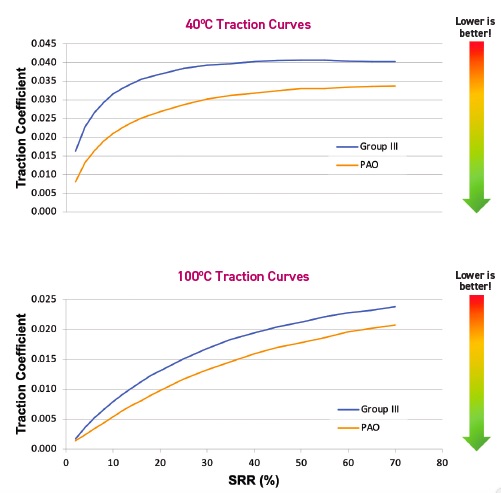 Figure 2. Friction comparison. Figure courtesy of Chevron Phillips Chemical.
Figure 2. Friction comparison. Figure courtesy of Chevron Phillips Chemical.
Hope adds that when it comes to critical functions of lubricants such as heat removal and thermal conductivity, the temperature differences documented in the 2002 SAE Gear Oil paper by Dirk Wienecke and professor Wilfred Bartz on base oil type showed that PAO-based gear oil was 7 to 17 C cooler than hydrocracked oil and 19 C cooler than mineral oil in bench and dyno tests.
6
Hope continues that the specific heat is the amount of heat per unit mass required to raise the temperature one degree Celsius.
•
The higher the specific heat, the greater the ability to absorb heat.
•
If the density and thermal diffusivity are constant, then the thermal conductivity and specific heat are proportional.
Furthermore, Hope says, “The specific heat at 120 C for PAO 4 is 2,510 J/kg-K compared to 2,256 for an equiviscous Group III oil; therefore the PAO will conduct 11% more heat than the mineral oil, enabling equipment modifications to improve automobile performance (i.e., turbochargers, engine gas recirculation [EGR] system, etc.)
(see Figure 3).”
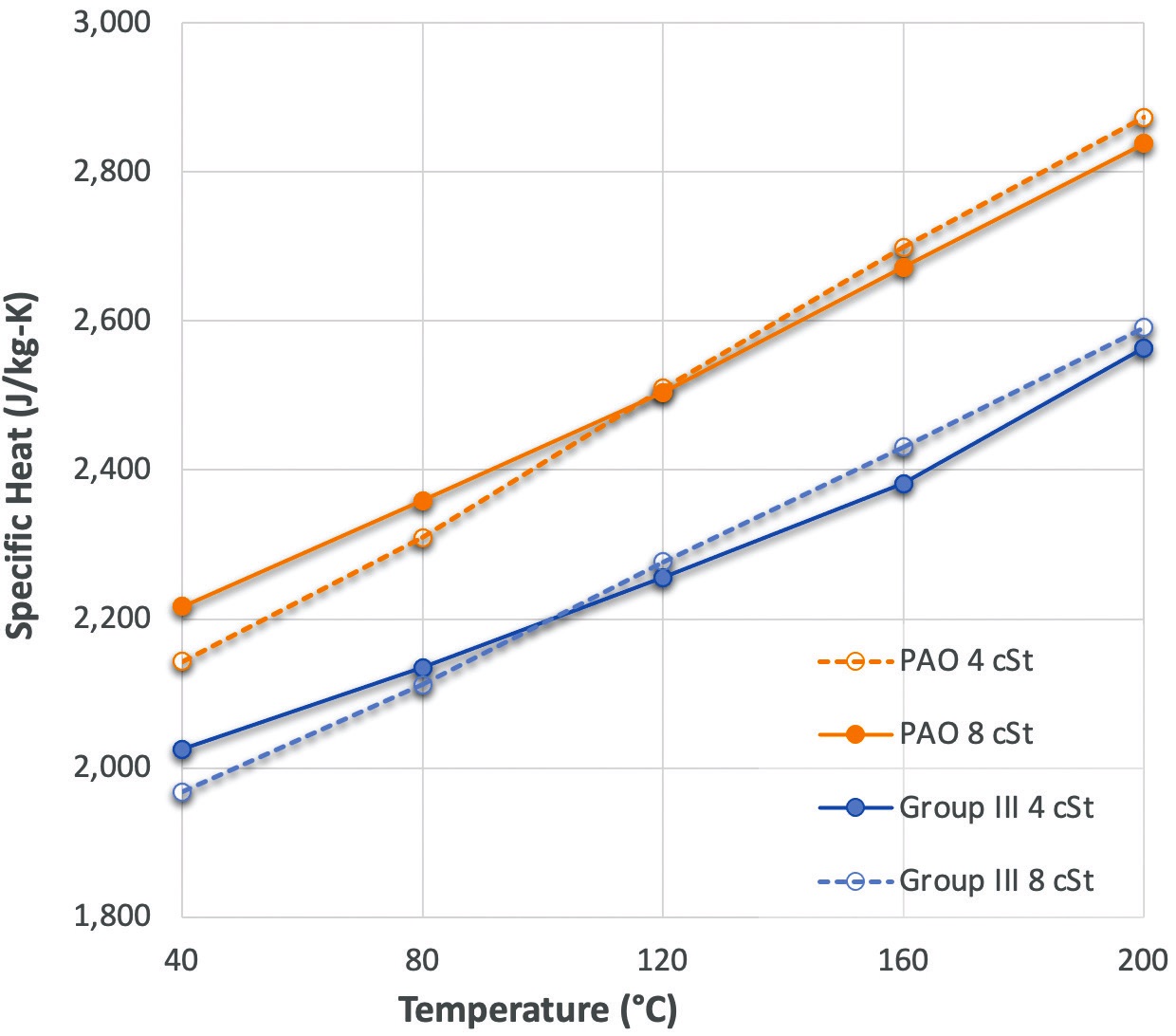
Figure 3. Heat removal and conductivity. Figure courtesy of Chevron Phillips Chemical.
Liang says, “PAOs have shown better performance results than Group III/Group III+/GTL base oils. PAO is routinely and historically better in cleanliness tests and higher temperature oxidation tests, where the PAO is more resilient to those demanding conditions. Also, the use of PAOs can enable improved viscometrics and, hence, benefit fuel efficiency. But, as ever, developing an effective lubricant solution is more than one dimension. We need to address many (dozens of) performance and physical attributes, and the greater flexibility that PAO can afford is a benefit.”
According to Schimmel: “Few lubricants are entirely based on PAOs; often the amount of PAO in a formulation is reduced to the minimum amount, which is necessary to meet specific performance requirements. The remainder is usually Group III base oil. The use of PAO is not common in many industrial applications, but also Group III base oils occupy only a minor share there. The notable exceptions are industrial gear oils and compressor oils, where the exceptional oxidative stability of PAOs allows for much longer oil drain intervals compared to mineral oils. However, cost considerations will allow Group III oils to take market share away from PAOs in the future.”
Liang says: “The trajectory for Group III utilization is very well known. This will continue. Ultimately the growth of Group III will expand to fill all applications, only limited by these parameters:
•
Cost (where Group II makes more sense)
•
Availability (where there is sufficient available volume to deploy)
•
Physical (where Group III just cannot hit the characteristics needed in the application).
In regard to applications that will be only suited for PAOs, Liang says, “The emerging and growing ultra-low viscosity applications for engine oils will still see the need for PAOs, due to physical limitations for Group IIIs, and any area where the commercial limitations for high quality Group III make PAOs as the only viable option.”
New developments
Liang says, “PAOs advance at a modest rate, largely to address the specific needs of ultra-low viscosity applications. There is very little by way of advancement in Group III advancements available. They will be marginal at best.”
He adds, “Additive technology is supporting PAO and Group III performances, and the additive development is driven by customer needs—largely performance versus cost. The solutions for Group III and PAO are not necessarily the same and require specific development. So the model is to be responsive to customer and market needs and develop the most cost-effective approach.”
Schimmel adds: “A novel PAO has recently been introduced to the market that combines a very low volatility and a low viscosity and, thus, enables the formulation of low viscosity engine oils without compromising the available space for additives. At the same time, manufacturers of Group III oils are further improving the properties of their base oils to move the performance parameters even closer to PAO.” In the end, it’s not a decision between PAO or Group III; both base oil groups will continue to find their markets, and a rapidly transforming automotive industry is constantly adding new performance requirements. The balance of performance and economic aspects will determine the space that these two base oil groups can occupy.”
Summary
The 21st century continues to see advancement in technology as societies place new demands on output and environmental performance. Applications are being designed to achieve higher production levels with increased energy efficiency and lower total cost of ownership. This results in new and different materials being used, greater power density, advances in seal technology, finer oil filtration, smaller lubricant capacity reservoirs if any, higher operating speeds, increased temperatures and higher system pressures, in addition to electric conductivity and sustainability demands for many applications that all place greater stress on lubricants. These requirements, coupled with the trends of reduced or maintenance-free operation, fill-for-life lubrication, the quest for more energy efficient lubricants, increased environmental awareness and regulations and greater attention to safety issues, will continue to challenge lubricant technology and drive associated research and development activities. Looking ahead, we can only imagine what new or adapted technologies will be needed to produce the energy of the future. What is known is that there will be moving parts that will require lubrication, but the lubrication may not remain in a volume, shape and form as we know it today.
REFERENCES
1.
Pirro, D. M., Webster, M., and Daschner, E. (2016).
Lubrication fundamentals, revised and expanded. CRC Press.
2.
Gladstein, Neandross & Associates (GNA). (2022), “The state of sustainable fleets market brief.” Available
here.
3.
McGuire, N. (2021), “The electric vehicle grease industry finds its bearings,” TLT,
77 (11), pp. 32-40. Available
here.
4.
Brown, S. (2015), “Base oil groups: Manufacture, properties and performance,” TLT, 71 (4), pp. 32-35. Available
here.
5.
Jacobs, C. (2021), “PAO springs forward,”
Lubes’n’Greases. Available
here.
6.
Wienecke, D. and Bartz, W. J. (2002), “Influence of gear oil formulation on oil temperature,” SAE 2002-01-1693, International Spring Fuels & Lubricants Meeting & Exhibition, Reno, Nev.